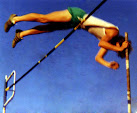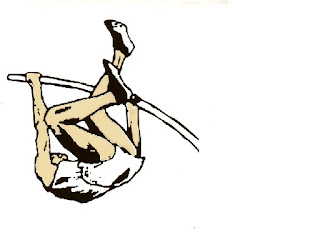
Pole Vault illustrations, photos, video, history, technique, help, and discussion of safety issues.
Monday, July 5, 2010
Sunday, July 4, 2010
Pole Vault Beginners: Getting Started.
Hello and welcome to all you pole vaulters out there.
I began this blog to help any of you who are wondering how you can improve your pole vault - and also to help beginners who want to learn safe and effective vaulting techniques. After 40 years of combined vaulting and coaching (with several champions to my credit and records of my own), I believe I am just the person who can help at any level of the event.
I will be submitting numerous illustrations and videos on this blog - to help define the vault in easy to understand steps. Keep checking this blog on a regular basis and ask questions. You will soon be on the fast track to pole vault success.
Leave your comments in the form below this post and I will try my best to answer them.
I began this blog to help any of you who are wondering how you can improve your pole vault - and also to help beginners who want to learn safe and effective vaulting techniques. After 40 years of combined vaulting and coaching (with several champions to my credit and records of my own), I believe I am just the person who can help at any level of the event.
I will be submitting numerous illustrations and videos on this blog - to help define the vault in easy to understand steps. Keep checking this blog on a regular basis and ask questions. You will soon be on the fast track to pole vault success.
Leave your comments in the form below this post and I will try my best to answer them.
Jerry Hock Pole Vault Memorabilia.
 |
| 1969 Orlando, Florida track meet newspaper clipping. |
 |
| Late 1960s high school track team. |
 |
| High School newspaper clipping, Jerry Hock 13-foot 6-inch school pole vault record. |
 |
| 1972 Raider Junior College track team. |
Saturday, July 3, 2010
Friday, June 4, 2010
Thursday, June 3, 2010
Wednesday, June 2, 2010
USA Track and Field Championships, Houston 1989.
Pole Vault Inversion-Training Device.
Tuesday, June 1, 2010
Winter Park High School 1970 Pole Vault Sequence Photo.
Pole Vault Training Illustration: Take-Off-Foot Detail.
Pole Vault Take-Off Illustrations.
Thursday, January 21, 2010
The Swing is a Key Element in Pole Vaulting.
Perfecting the swing-phase of your pole vault is a key element in improving your vault.
In the past, I have worked diligently with beginning vaulters to ensure a correct take off step - because I have found that this one phase done correctly makes the most difference in the overall vault. Done incorrectly the take off can adversely affect the vault and make it impossible to improve.
With that said, I will now talk about the swing mechanics - with the assumption you are taking off correctly with your step directly under your top hand and thinking about running straight forward through the pit. What happens just at the second your pole tip contacts the back of the box is that your body becomes stretched from the top hand to the toes of the take off foot as your front leg and knee are driving forward to pull you into the pit. This long line forms the pendulum that is used to generate the speed of the rock back phase. The instant the stretch of the forward penetration feels complete, the vaulter should make a conscious and exerted effort to swing the trail leg rapidly to the pole in a long line from the top hand. Think of a sling with a rock in it. This swinging action must be deliberately, with practice, and must be performed technically and correctly to be effective.
Watching videos of world class top vaulters - while slowing and stopping the action pauses these miraculous vaults during swing stage and gives a vaulter a visual idea of how the swing looks - in action and performed accurately. You will notice that the top vaulters combine the drive phase and the swing into one continuous motion. These top vaulters are aiming for maximum penetration by running straight through the take off while swinging the longest extension of their body rapidly through the bottom of the vault and to the pole - all generating tremendous power - which propels the reverse action and throws the body upside down without having to pull it back or struggle to get back. The body will be spun backwards with great force as the trail leg is shortened and tucked close to the pole as the swing transitions into the tucking rock back.
Think of an ice skater and how they spread their arms and spin. When they bring their arms tight to the body, the spin speed increases dramatically. This is what we want to see with the pole vault swing - body propulsion.
When the trail leg cranks from the take off step - and at the point the toe of the take off step is pushing off the ground to the point the toe passes the pole, this is the phase in which degrees of swing are generated. You can actually swing harder to accelerate your penetration.
Practice the swing on short runs and pop ups until you start to feel yourself controlling and perfecting the technique.
There are coaches who insist that when the run and plant are done correctly, the swing will take care of itself. I agree in principle and this is true for novice vaulters. Great vaulters will always have control of their swing and use it to ensure their complete reverse action and speed in achieving it.
Sergei Bubka is The Vaulter whose swing phase I would recommend observing. American vaulter Dean Starkey also has a superior swing phase.
In the past, I have worked diligently with beginning vaulters to ensure a correct take off step - because I have found that this one phase done correctly makes the most difference in the overall vault. Done incorrectly the take off can adversely affect the vault and make it impossible to improve.
With that said, I will now talk about the swing mechanics - with the assumption you are taking off correctly with your step directly under your top hand and thinking about running straight forward through the pit. What happens just at the second your pole tip contacts the back of the box is that your body becomes stretched from the top hand to the toes of the take off foot as your front leg and knee are driving forward to pull you into the pit. This long line forms the pendulum that is used to generate the speed of the rock back phase. The instant the stretch of the forward penetration feels complete, the vaulter should make a conscious and exerted effort to swing the trail leg rapidly to the pole in a long line from the top hand. Think of a sling with a rock in it. This swinging action must be deliberately, with practice, and must be performed technically and correctly to be effective.
Watching videos of world class top vaulters - while slowing and stopping the action pauses these miraculous vaults during swing stage and gives a vaulter a visual idea of how the swing looks - in action and performed accurately. You will notice that the top vaulters combine the drive phase and the swing into one continuous motion. These top vaulters are aiming for maximum penetration by running straight through the take off while swinging the longest extension of their body rapidly through the bottom of the vault and to the pole - all generating tremendous power - which propels the reverse action and throws the body upside down without having to pull it back or struggle to get back. The body will be spun backwards with great force as the trail leg is shortened and tucked close to the pole as the swing transitions into the tucking rock back.
Think of an ice skater and how they spread their arms and spin. When they bring their arms tight to the body, the spin speed increases dramatically. This is what we want to see with the pole vault swing - body propulsion.
When the trail leg cranks from the take off step - and at the point the toe of the take off step is pushing off the ground to the point the toe passes the pole, this is the phase in which degrees of swing are generated. You can actually swing harder to accelerate your penetration.
Practice the swing on short runs and pop ups until you start to feel yourself controlling and perfecting the technique.
There are coaches who insist that when the run and plant are done correctly, the swing will take care of itself. I agree in principle and this is true for novice vaulters. Great vaulters will always have control of their swing and use it to ensure their complete reverse action and speed in achieving it.
Sergei Bubka is The Vaulter whose swing phase I would recommend observing. American vaulter Dean Starkey also has a superior swing phase.
Subscribe to:
Posts (Atom)
























